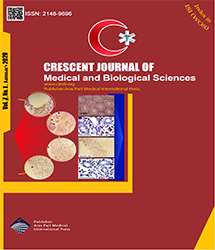
| Original Article | |
| The Relationship of Self-effcacy and Demographic Characteristics With Blood Glucose Control in Iranian Older Adults With Diabetes Type II: A Cross-Sectional Study | |
| Shirin Azadi1, Faranak Jabbarzadeh2, Nasser Aghamohammadzadeh3, Parvin Sarbakhsh4, Fariborz Roshangar2 | |
| 1MSc in Medical Surgical Nursing School of Nursing and Midwifery, Tabriz University of Medical Sciences, Tabriz, Iran 2Department of Nursing, Faculty of Nursing and Midwifery, Tabriz University of Medical Sciences, Tabriz, Iran 3Endocrine Research Center, Tabriz University of Medical Sciences, Tabriz, Iran 4Department of Statistics and Epidemiology, School of Public Health, Tabriz University of Medical Sciences, Tabriz, Iran |
|
|
CJMB 2020; 7: 96–103 Viewed : 5251 times Downloaded : 3592 times. Keywords : Self-effcacy, Glycosylated hemoglobin, Demographic characteristics, Diabetes type II |
|
| Full Text(PDF) | Related Articles | |
| Abstract | |
Objectives: The present study was conducted to investigate the relationship of self-effcacy and demographic characteristics with blood glucose control in older patients with diabetes type II who referred to an endocrinology clinic in the northwest of Iran. Materials and Methods: This descriptive cross-sectional study was conducted using a random sampling method through which the patients were divided into controlled and uncontrolled groups. A total of 290 eligible volunteers participated in the research during November-March 2016. The Diabetes Management Self-effcacy Scale and demographic information form were completed by face-to-face interviews. Based on the hemoglobin A1c (HbA1c) level, the patients were assigned to controlled (HbA1c<7) and uncontrolled (HbA1c>7) groups. Finally, the data were analyzed using SPSS. Results: The results showed a signifcant difference between the 2 groups regarding the mean self-effcacy scores after adjusting for the blood glucose control confounding variables (P≤0.05). Moreover, all the dimensions of participants’ self-effcacy scores had signifcant relationships with the glycosylated hemoglobin level (P≤0.05). In terms of personal details, variables including the time since diagnosis of diabetes, education, and economic status had signifcant relationships with blood glucose control as well (P≤0.05). Conclusions: In general, the economic status, education, and time since diagnosis of diabetes affected diabetes control. Thus, performing interventions to improve the self-effcacy and well-being of these patients can improve their self-care and blood glucose control. |
Cite By, Google Scholar
Google Scholar
PubMed
Online Submission System
 CJMB ENDNOTE ® Style
CJMB ENDNOTE ® Style
 Tutorials
Tutorials
 Publication Charge
Medical and Biological Research Center
About Journal
Publication Charge
Medical and Biological Research Center
About Journal
Aras Part Medical International Press Editor-in-Chief
Arash Khaki
Deputy Editor
Zafer Akan


















